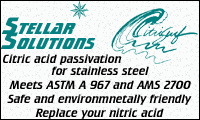
Curated with aloha by
Ted Mooney, P.E. RET

The authoritative public forum
for Metal Finishing 1989-2025

-----
Passivation of aluminum used in food service equipment
I WOULD LIKE TO KNOW IF ALUMINUM THAT IS FIRST CLEANED BY CALCINED (CALCINATED?) SODA AND THEN PASSIVATED WITH HYDROGEN NITRATE IS CONSIDERED SAFE FOR USE ON EQUIPMENT THAT COMES IN CONTACT WITH FOOD? THANK YOU
MARK HENRYBUYER - WHITE PLAINS, New York
2007
Please clarify the procedure. Is it 1) Abrasive blasting with baking soda, followed by 2) Treatment with nitric acid? [Note: hydrogen nitrate is anhydrous nitric acid]. Is this an initial cleaning only, or a process which may be repeated?
Nitric acid at higher concentrations gives only a temporary passivation to aluminum, protecting it from further attack by the acid. Rinsing with water will remove the passivation (a slightly toxic, soluble, aluminum nitrate film), leaving bare aluminum. Upon drying, the aluminum becomes covered with a very thin aluminum oxide film. This may be sufficient protection for contact with non-acidic, non-salty foods.
See the Aluminum Association (http://www.aluminum.org) publication
'Guidelines for the Use of Aluminum with Food and Chemicals, 1994' for additional information.
- Goleta, California
Rest in peace, Ken. Thank you for your hard work which the finishing world, and we at finishing.com, continue to benefit from.
2007
Passivation means different things for different metals. Sometimes it means removing iron contamination from the surface of non-ferrous material such as your aluminum equipment. If that is what you are aiming for here, a citric acid formulation (i.e. the type used for passivating stainless steel) does the job. Let us know if we can help you.

Ray Kremer
Stellar Solutions, Inc.
McHenry, Illinois

2007
Q, A, or Comment on THIS thread -or- Start a NEW Thread